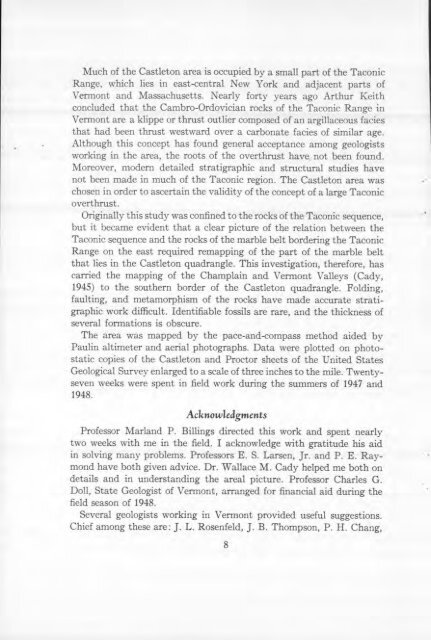STRATIGRAPHY AND STRUCTURE CASTLETON AREA VERMONT
STRATIGRAPHY AND STRUCTURE CASTLETON AREA VERMONT
STRATIGRAPHY AND STRUCTURE CASTLETON AREA VERMONT
You also want an ePaper? Increase the reach of your titles
YUMPU automatically turns print PDFs into web optimized ePapers that Google loves.
Much of the Castleton area is occupied by a small part of the Tacoruc<br />
Range, which lies in east-central New York and adjacent parts of<br />
Vermont and Massachusetts. Nearly forty years ago Arthur Keith<br />
concluded that the Cambro-Ordovician rocks of the Taconic Range in<br />
Vermont are a klippe or thrust outlier composed of an argillaceous facies<br />
that had been thrust westward over a carbonate facies of similar age.<br />
Although this concept has found general acceptance among geologists<br />
working in the area, the roots of the overthrust have not been found.<br />
Moreover, modern detailed stratigraphic and structural studies have<br />
not been made in much of the Taconic region. The Castleton area was<br />
chosen in order to ascertain the validity of the concept of a large Taconic<br />
overthrust.<br />
Originally this study was confined to the rocks of the Taconic sequence,<br />
but it became evident that a clear picture of the relation between the<br />
Taconic sequence and the rocks of the marble belt bordering the Taconic<br />
Range on the east required remapping of the part of the marble belt<br />
that lies in the Castleton quadrangle. This investigation, therefore, has<br />
carried the mapping of the Champlain and Vermont Valleys (Cady,<br />
1945) to the southern border of the Castleton quadrangle. Folding,<br />
faulting, and metamorphism of the rocks have made accurate stratigraphic<br />
work difficult. Identifiable fossils are rare, and the thickness of<br />
several formations is obscure.<br />
The area was mapped by the pace-and-compass method aided by<br />
Paulin altimeter and aerial photographs. Data were plotted on photostatic<br />
copies of the Castleton and Proctor sheets of the United States<br />
Geological Survey enlarged to a scale of three inches to the mile. Twentyseven<br />
weeks were spent in field work during the summers of 1947 and<br />
1948.<br />
Achnowledgments<br />
Professor Marland P. Billings directed this work and spent nearly<br />
two weeks with me in the field. I acknowledge with gratitude his aid<br />
in solving many problems. Professors E. S. Larsen, Jr. and P. E. Ray -<br />
mond have both given advice. Dr. Wallace M. Cady helped me both on<br />
details and in understanding the areal picture. Professor Charles G.<br />
Doll, State Geologist of Vermont, arranged for financial aid during the<br />
field season of 1948.<br />
Several geologists working in Vermont provided useful suggestions.<br />
Chief among these are: J. L. Rosenfeld, J. B. Thompson, P. H. Chang,













